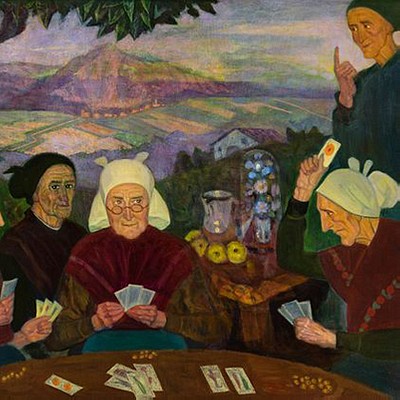JOAQUIM TERRUELLA MATILLA (Barcelona, 1891 - 1957). "Beach scene". Oil on canvas.
Lot 79
About Seller
Setdart Auction House
Carrer Aragó 346
Barcelona
Spain
Setdart Subastas was born in 2004 and is currently the first online art auction in Spain with solidity, prestige and reliability guaranteed by our more than 60,000 users. Setdart has a young, dynamic and enterprising team ready to successfully manage the purchase and sale of art works through custom...Read more
Estimate:
EUR€10,000 - EUR€12,000
$10,752.69 - $12,903.23
Absentee vs Live bid
Two ways to bid:
- Leave a max absentee bid and the platform will bid on your behalf up to your maximum bid during the live auction.
- Bid live during the auction and your bids will be submitted real-time to the auctioneer.
Bid Increments
| Price | Bid Increment |
|---|---|
| EUR€0 | EUR€10 |
| EUR€200 | EUR€25 |
| EUR€500 | EUR€50 |
| EUR€1,000 | EUR€100 |
| EUR€3,000 | EUR€200 |
| EUR€5,000 | EUR€500 |
| EUR€10,000 | EUR€1,000 |
| EUR€20,000 | EUR€2,000 |
| EUR€50,000 | EUR€5,000 |
About Auction
By Setdart Auction House
Dec 14, 2021
Set Reminder
2021-12-14 08:00:00
2021-12-14 08:00:00
America/New_York
Bidsquare
Bidsquare : 19th & 20th Century Fine Art
https://www.bidsquare.com/auctions/setdart-auction-house/19th-20th-century-fine-art-7992
Gaudi, Sorolla, Torres Garcia, Maclet, TSUGUHARU FOUJITA, Benjamin Palencia Setdart Auction House sofia@setdart.com
Gaudi, Sorolla, Torres Garcia, Maclet, TSUGUHARU FOUJITA, Benjamin Palencia Setdart Auction House sofia@setdart.com
- Lot Description
JOAQUIM TERRUELLA MATILLA (Barcelona, 1891 - 1957). "Beach scene". Oil on canvas. Signed in the lower left corner. Measurements: 106 x 140 cm; 135 x 171 cm (frame). By the orography of the landscape it is probable that it is a representation of the beach of Llançà, located in the province of Gerona. The aforementioned idyllic landscape was portrayed several times by the artist, as can be seen in the collection of Baroness Carmen Thyssen, who owns the works Playa de LLança and Playa de Port de Llançà, from 1946. The scene shows a technique that is aware of the aesthetic advances and pictorial proposals that the Impressionists contributed to the history of art, and especially to the way of apprehending the landscape. It is an everyday beach scene, starring several characters, small in size, dressed in brightly colored costumes, organized in groups on the seashore. At the beginning of the strip of water we see several beached boats, and finally a sea where they produce expressive reflections, echo of the luminous atmosphere that dominates the scene. Nephew and follower of Segundo Matilla, Joaquín Terruella was also a disciple of Santiago Rusiñol. With the latter he made a trip to Italy in 1923, in addition to spending a season working together in Aranjuez. He also painted in Paris and Palma de Mallorca. He exhibited individually for the first time in the disappeared Goya room in Barcelona, in 1916, and since then he showed his work in other rooms in Barcelona, such as Parés and Gaspar, and also in Paris, Madrid, Palma, Zaragoza, Bordeaux and Biarritz. In 1956 he held his last exhibition at the Busquets Gallery in Barcelona. Since then his work has been present in different collective and anthological exhibitions such as the one held in the Gothsland room in Barcelona in 1985. In 1993, Ángeles Cortina brought together a series of his oil paintings and drawings in her Barcelona gallery. Joaquín Terruella was a fundamentally landscape painter, situated in the wake of impressionism, who reflected the Catalan landscape with delicacy and subtle transparency. Another of his favorite subjects was the world of bullfighting, and in fact he worked as a bullfighting illustrator for the publications "El Día Gráfico" and "La Noche". He also worked on scenes of gypsies and concert cafés. His work is preserved in the Museum of Contemporary Art of Barcelona, the Museum of Contemporary Art of Madrid and the Provincial Museum of Lugo.
- Shipping Info
-
In-house shipping available. Please inquire at admin@setdart.com.
-
- Buyer's Premium



 EUR
EUR CAD
CAD AUD
AUD GBP
GBP MXN
MXN HKD
HKD CNY
CNY MYR
MYR SEK
SEK SGD
SGD CHF
CHF THB
THB



















